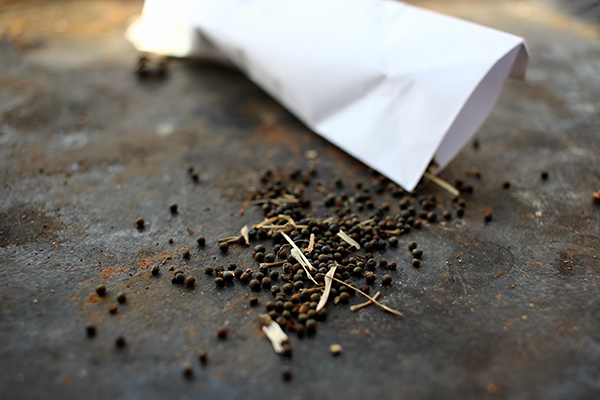To cultivate forest garden plants from seed is a science in itself, with as many rules as exceptions. A good technique I figured tell about in this post is to use the autumn sowing. Unlike annuals, where many are adapted to warmer climates, forest garden plants usually permanent and well-adapted to our cold climate. Many of them want to be absolutely sure that it is really spring when they germinate so that they do not happen to sprout a warm autumn and then freeze and die in winter. Therefore, they must first go through a more or less long period of cooling (Thus, a whole winter), for them to be viable. Exposing the seeds for this cold treatment is called stratification. A very simple way of stratifying the seeds is to sow them now in the autumn.

I usually take a plastic brim and put a newspaper in the bottom, refill with a mixture of 1 Some flat land and 1 Some little coarse sand, so the seeds and cover with a thin layer of såjordsblandningen. Then I water carefully and if there is a risk that seeds from other plants (t.ex. björk) ending up in såbrättet I cover it over with fiber cloth until all other plants have released their seeds. The brim can be left outdoors all winter. If you want to get started a little earlier, you can take in the brim of a greenhouse forward spring, but I usually do not bother about it, but leave them there until the seeds germinate, which can happen anywhere between March and May, depending on how hot it is out.
Most perennial vegetables (except legumes, which have sometimes proved itself to rot in the soil during winter) I reproduce in this way and it is easy to get a hundred new plants from a single såbrätte. This year winter planted example, I:
| Botanical name | Family | Swedish name |
|---|---|---|
| Allium cernuum | Alliaceae | Prärilök |
| Brassica oleracea ssp. oleracea | Brassicaceae | Helgoländer Wildkohl |
| Bunias orientalis | Brassicaceae | Ryssgubbe |
| Camassia leichtlinii | Asparagaceae | Edible star hyacinth |
| Campanula latifolia | Campanulaceae | Bellflower |
| Chenopodium bonus-henricus | Amaranthaceae | Good henriks målla |
| Claytonia sibirica | Portulacaceae | Vårsköna |
| Crambe cordifolia | Brassicaceae | Crambe cordifolia |
| Crambe maritima | Brassicaceae | Strandkål |
| Hablitzia tamnoides | Amaranthaceae | Rankspenat |
| Lepidium leaved | Brassicaceae | Bitterkrassing |
| Levisticum officinale | Apiaceae | Libsticka |
| Malva moschata | Malvaceae | Myskmalva |
| Matteuccia strutheopteris | Onocleaceae | Ostrich fern |
| Athamanticum Meum | Apiaceae | Björnrot |
| Myrrhis odorata | Apiaceae | Spanish chervil |
| Oxyria digyna | Polygonaceae | Scales Acid |
| Ornithogalum pyrenaicum | Asparagaceae | Spanish stjärnlök |
| American Pokeweed | Phytolaccaceae | American pokeweed |
| Podophyllum I hexand | Berberidaceae | Himalayan may |
| Rumex rugosus | Polygonaceae | Garden Acid |
| Rumex patientia | Polygonaceae | Spenatskräppa |
| Rumex sanguineus | Polygonaceae | Skogsskräppa |
| Salsify hispanica | Asteraceae | SCORZONERA |
| Sium sisarum | Apiaceae | Sockerrot |
| Smyrnium olusatrum | Apiaceae | Alexanderloka |
Even seeds from trees and shrubs usually need to be stratified and it works great to winter seed from wild cherry (Prunus avium), havtorn (Hippophae rhamnoides) and Elaeagnus umbellata (Elaeagnus umbellata) to stone pine (Pinus sylvestris) and all the other nut varieties we can grow in our climate. Just with nuts apply, however, to make såbrättet mussäkert, so as not to lose the nuts for the winter.



Thanks for that! Should do the same…
from hjärtnötter (trees and hazelnuts) I picked after being sent to you, I've put in two different places. Partly a bucket of sand hanging from a rope in the attic of an outbuilding (Thus cold and mussäkert) and partly in the daughter sandbox (cold but not mussäkert). I will return with outcome.
How nice! then I will so some seeds that otherwise I will surely forget that our (:D
Anyone know where to get hold of the Russian strawberry seeds?
At least in the Stockholm area (for example, in the meadows between Stockholm University and Lappkärrsberget) there are lots of wild Russian strawberry, så om du vistas härikring kan du nog plocka en hel del frön själv. Just nu blommar bestånden för fullt.
Vattnar du nåt mer sen innan våren?
No, det brukar räcka med den fukt som kommer åt fröna naturligt.
/Philipp
Jag hittade det här inlägget för ett tag sen https://littlehouseontheurbanprairie.wordpress.com/2010/11/06/chestnuts-and-hazels-for-the-future/
Påminner lite om din metod.
/Alexander
Tack! Det var precis den typen av bilder jag hade behövt till inlägget, vad bra att du hittade den där sidan 🙂
Greetings
Philipp